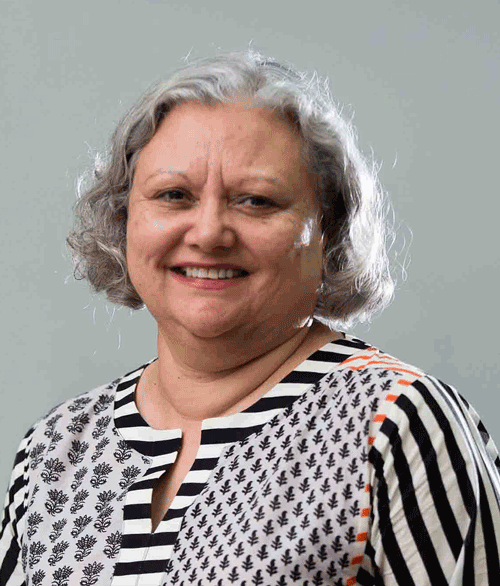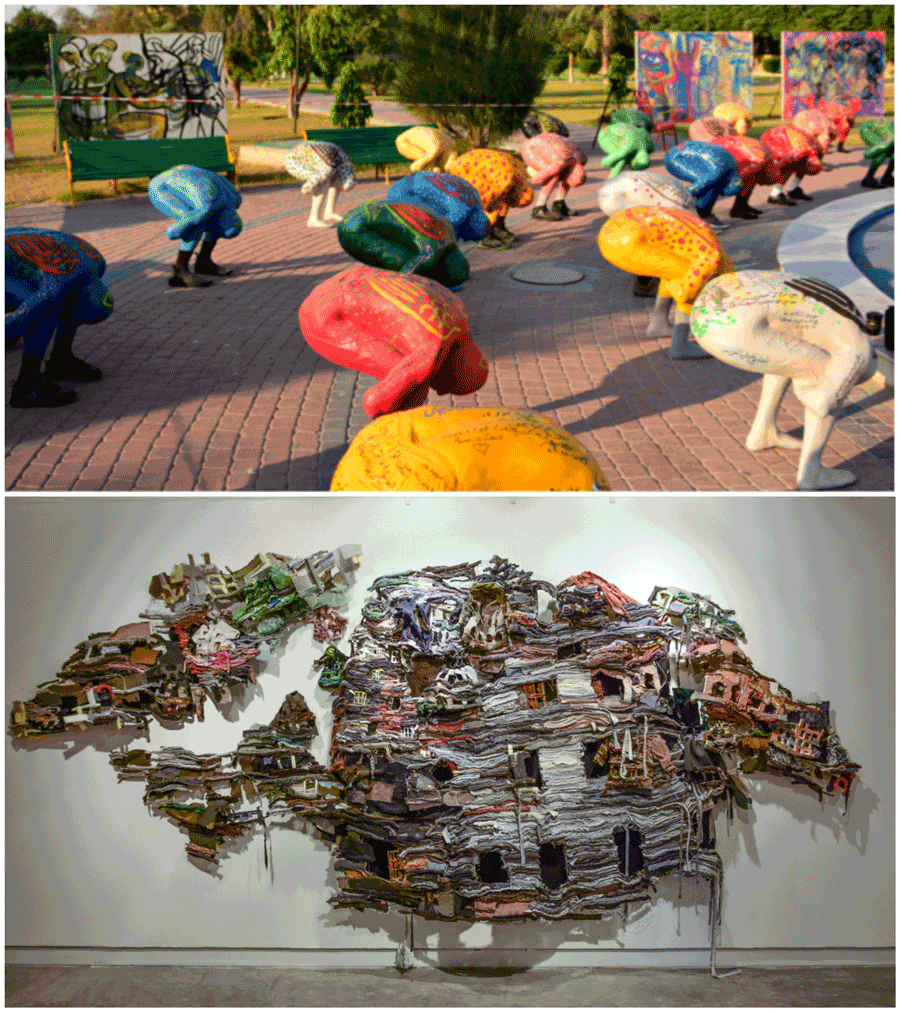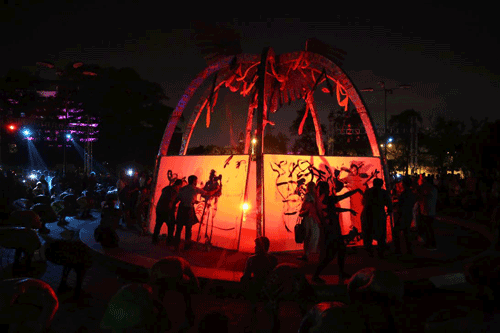Interview: Niilofur Farrukh
By Zoha Liaquat | Art Line | Interview | Published 6 years ago
Since the city saw its first Biennale in 2017, there is great enthusiasm for the second instalment. What should people be expecting this time around?
With the first Biennale it was a bit of trial and error. Of course there was research and a team of dedicated individuals working tirelessly to get everything right but we were also in the process of figuring out what worked and what didn’t. There were some major takeaways, especially the absence of local languages in the artwork that was curated; so that’s one thing we have paid special attention to, ensuring that we incorporate as much Urdu as we possibly can. It has been particularly challenging because there aren’t many art translators, but we’re adamant to make that a focus for the next Biennale. Additionally, this year’s theme has a more environmental focus as opposed to a political one and for that we are looking at the city’s public parks, in particular, to showcase the artwork. There is an increased focus on making it even more accessible than it was in 2017.
 Why the focus on Urdu?
Why the focus on Urdu?
Because for the longest time we have studied and spoken about western art, without much regard for the fact that Pakistan has some incredible work of its own, work that resonates more with our culture than anything produced in the West. The entire purpose of a Biennale is to bring art into the public space and encourage dialogue around it, none of which would be impactful if we chose to communicate in any language other than the one spoken in our part of the world.
There is always a highbrow attitude attached with art, and so it never has the same reach as that of film or even literature. How does a Biennale change that?
Well first, it is important that it isn’t condescendingly talked down to the audience, which is where a Biennale comes into play. It demystifies art by bringing it to your locality, away from the confines of a gallery, which is often perceived to be an elitist space. Of course that doesn’t automatically guarantee a widespread interest in art, some people will like it, some won’t. But at least it encourages the formation of a community, bringing like-minded people together to share a space where they can talk about something they enjoy. Also, the audience at a Biennale, unlike that at a gallery, does not comprise only people who have studied art or understand its deeper meanings; a Biennale always sees an influx of young people fascinated by the event and the artwork being showcased within, which encourages dialogue. The people in attendance will not shy away from sharing their opinions out of the fear of sounding ill-informed. None of this happens right after the first Biennale, but by the time we organise a fifth Biennale in the city, I am hopeful we would have managed to create greater interest in art than we see at this point.
The first Biennale received a lot of appreciation but there were those who questioned the city’s need for a Biennale. How do you respond to that?
I think that particular criticism came from a theoretical point of view, but with art theory only remains relevant to a point. I have said this before too, that a Biennale can be anything you want it to be, and we are hoping to make it as Karachi-centric as we can. There is always criticism when something is done on such a large scale, but I don’t quite agree with the notion that Karachi does not need a Biennale. The purpose of a Biennale is by no means to trivialise the harsh realities of life in the city; in fact it does quite the opposite. Art is a medium for political expression and a great one at that; it encourages discourse and there is no reason why the residents of Karachi should be deprived of that.
Speaking of political expression, is there any self-censorship when it comes to the art that is curated for the Biennale or are the artists given free rein?
There are two ways in which censorship works. One is where state authorities intervene and specifically ask you to steer clear of commenting on certain subjects. I have never been one to condone these restrictions on artistic expression. As far as the artists are concerned they have the liberty to touch upon any themes they want, as long as it remains within the realm of the larger theme selected for the Biennale. However, there is another form of censorship, and that might not even be the right word to use here. This has more to do with adhering to certain cultural sensibilities, and that is something I am especially mindful of. This is also an extremely important consideration for a Biennale because the art is displayed in public spaces. I have been serving on the International Art Critics Association’s (AICA) committee for Freedom of Expression for over a decade and its sole purpose is to protect artists from censorship, but we have not always ruled in favour of the artists. This one time we deliberated on a case from Japan, which as one would understand is a fairly progressive country, where the artists had painted close-ups of the female genitalia and the backlash from the community was such that the exhibition had to be shut down the next day. In cases like these, one has to understand what a community wants and has to comply with that.

Diversifying the conversation: Displays at the Karachi Biennale 2017.
Does this not then encourage a mob mindset?
Not particularly, because art is a reflection of the community so there has to be a certain boundary to it and it is unfair to relate that with censorship per se. For instance, in the United States any form of underage nudity in artwork is strictly prohibited because they do not want any of the art to hint at child pornography, even the more classic pieces that once featured minors without any clothes on are prohibited from being replicated and redistributed. Now that is something nobody objects to, because we all understand the repercussions of allowing artwork that might intentionally or unintentionally promote child pornography. In the same way many people would be uncomfortable around artwork surrounding the male or female genitalia and it is important that they be given this choice to decide what they do or do not want to see within their community.
You’ve spoken about community, and about bringing art into the public space. What has the last year been like in that regard – have you seen new artists take more interest in showcasing their work in their communities/localities?
The thing about artists is that they do not necessarily function within their own localities, and it is not fair to expect a sudden burst of artwork at every nook and corner right after the first Biennale. Galleries are still very important to artists as the prime space to present their work in and even with the Biennale in the works we are not looking to change that. But yes, there have been some great student-led projects around the city. Recently, we worked on the ‘I am Making a Library’ project in collaboration with Tetley UK and in partnership with Alliance Francaise and the Orangi Pilot Project. A small group of about 11 students were involved in setting up a mobile library which opened to the public at the Alliance Francaise first and was then moved to the Organi township, and is currently the only children’s library in the area. This is the kind of work we are focusing on most; art is not limited to paintings and sculpture, it can take any form and it mobilises the community in so many different ways.
With preparations for the second Biennale underway, what has it been like choosing a curator and what new thing is he bringing to the table?
One thing that we were really focused on was finding someone who would be as passionate about the Biennale as we are, someone who would be willing to go the extra mile and treat it as more than just another feather in his cap, and luckily for us Zeeshan is all of that and more. He is young, so of course very energetic and hands-on as well. Because the focus this year is to localise the Biennale as much as possible, he has been conducting extensive research, going to different areas in the city, meeting people from different walks of life and getting their opinion on art in the public space. What they think of it, what kind of art would they expect to see. He wants to get a sense of what the community is looking for, the idea being to converge that with his own sensibilities and curate work for the Biennale. We are all keen on keeping the Biennale as relevant to the city as possible and expanding the scope, instead of focusing on specific areas. There is a lot of travel involved; it is not just isolated to what people are looking for but also what is happening at Biennales around the world so he has been attending those, meeting with artists in every corner. The great thing about Zeeshan is that he not only understands the city but his curatorial practices are also centred on the idea that artwork – especially that showcased in a Biennale – should reflect the socio-political climate of the city.
Lastly, how do you see the city’s art scene evolving through the course of five Biennales, for instance?
First and foremost, we hope to decentralise conversation around art. Like you had said earlier, there is still a lot of hesitation when it comes to discussing art, so the idea is to really engage as many people in the city as we can. Not just art students or collectors, not just people who regularly visit galleries and keep up with the art scene. The whole idea of taking art into the public space is to instil an interest; even during the first Biennale a lot of people showed up only because they knew about an event happening in their locality, it was only after they experienced the Biennale in all its glory that people became more receptive to it. So I think for the first two or three Biennales our focus is to encourage people to talk about art and from there it will be more about building a bigger community of art enthusiasts. Even though there are galleries in different parts of the city, there still aren’t enough. Maybe once the Biennale becomes popular, communities will start demanding the opening of more galleries, because until the community doesn’t push for it, art cannot flourish to its full capacity.
A journalism graduate, Zoha's core areas of interest include human and gender rights issues, alongside which she also writes about gender representation in the media and its impact on society.


